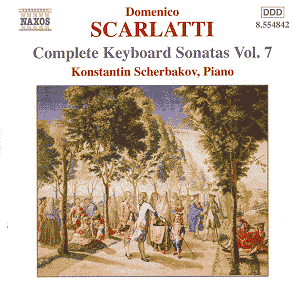Domenico
Scarlatti as born in 1785, the same year as Bach and Handel,
and studied in Naples with his father Alessandro and in Venice
with Francesco Gasparini. It was in Venice that he met Handel,
who was in the city to advance his understanding of the Italian
opera. Thereafter Scarlatti travelled widely working in Rome,
London, and Lisbon, before returning home to Naples in 1725.
Four years later he moved to Madrid, where he lived for practically
all his remaining years.
Scarlatti
is chiefly famous for his five hundred and fifty keyboard sonatas,
a body of work which developed the expressive range of this
musical genre to an extraordinary degree. In common with his
exact contemporary Bach, he wrote for the harpsichord with such
verve and imagination that his music sounds equally well (if
not better) on the modern piano; indeed it has rightly become
a standard feature of the repertoire. The structures of the
sonatas are considerably varied. The two featured here are both
single movements.
This
is Volume 7 in Naxos’s Scarlatti project with various pianists.
Konstantin Scherbakov has an imaginative and sensitive touch
as a performer of this repertoire. His playing is true to the
baroque stylistic origins of the music, while also pointing
up its emotional possibilities. Excepting ‘purists’ who cannot
endure this music on a modern piano, Scherbakov will give the
listener the utmost pleasure.
There
is a subtle range of repertoire, affording the determined listener
the possibility of listening to the complete programme. However,
the greatest rewards are likely to be gleaned by taking a grouped
few pieces according to circumstances.
The
expressive and technical range among these sonatas should not
be taken for granted, not least in the longer items such as
the extraordinary F major Sonata, the second item on the disc.
There are few items in the minor key among this compilation,
so that when one does arrive it stands out the more strongly.
Perhaps it is for this reason that the substantial Sonata in
F minor makes a particular impression, with its darkly expressive
nature.
The
recording too does justice to Scarlatti, since it is both atmospheric
in ambience and clear in detail. This is a useful balance, which
allows the details of the music’s imaginative textures to be
experienced naturally. Since he has so many sonatas to his credit,
it is all too tempting to consider that Scarlatti composed to
a formula. In fact nothing could be further from the truth,
and this most recent issue in the valuable Naxos collection
can therefore be welcomed with enthusiasm.
Terry
Barfoot

![]() Konstantin Scherbakov (piano)
Konstantin Scherbakov (piano)![]() NAXOS
8.554842 [64.02]
NAXOS
8.554842 [64.02]





